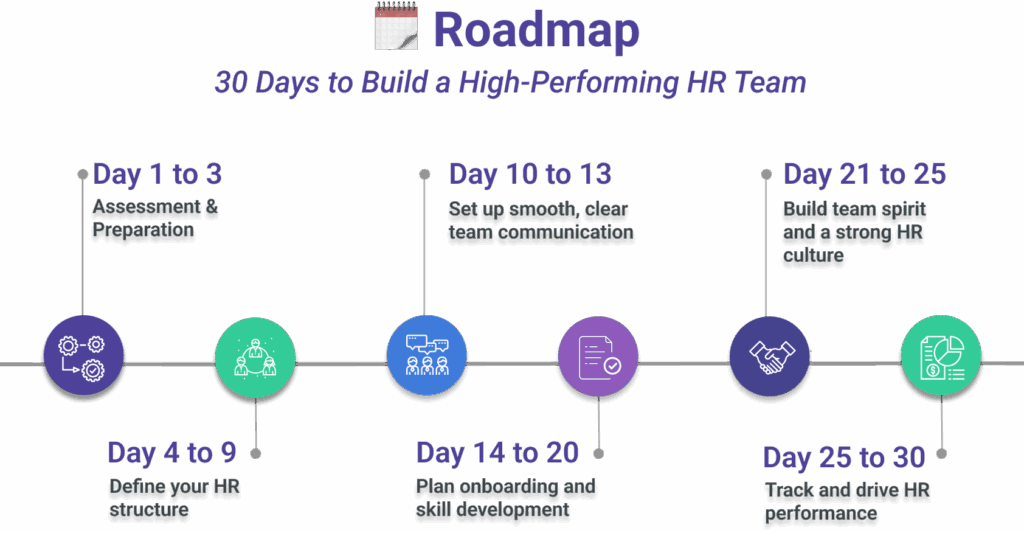
In France, 60% of HR leaders say they don’t have the resources they need to do their jobs1.
If you’re here, chances are you’re one of them. Or maybe you’ve just joined a company where everything needs to be built from the ground up, or at least improved. In a world where HR teams are being pulled in every direction, it’s tough to meet everyone’s expectations and still stay on top of all your tasks.
In 2023, 79% of HR pros said they were getting more requests from employees2.
And you probably know better than anyone how much that increase can directly impact your team’s efficiency.
On top of that, shifting employee expectations, new laws, and never-ending processes aren’t exactly working in your favor. When things pile up, being short-staffed in HR can hit hard and fast. In fact, 81% of HR professionals say they’re close to burnout². That’s a stat you can’t ignore, and it shows just how crucial it is to strengthen your team.
Those numbers are pretty alarming, and they can be discouraging. But that’s exactly why we’re here: to help you navigate this transition. In this article, we’ll walk you through how to build a strong HR team in just 30 days, one step at a time. And just to be clear, wanting to improve your team doesn’t mean it’s not doing a great job already. It just means there are ways to take things to the next level!
Related articles:
How to Implement AI in Performance Management
How to Predict Employee Turnover Using AI and HR Analytics
Step-by-Step Guide to Build a Strong HR Team
Day 1 to 3: Assessment and Prep
Day one is the most important. It’s the starting point for everything that comes next. So it’s key to set the right tone from the get-go. If you want to build a high-performing HR team, you’ve got to start at square one.
Before you dive into action, taking stock of where things stand is crucial. It’s the only way to make sure your next steps actually line up with what your team really needs.
To run this assessment, here’s what you’ll want to take a closer look at the following three aspects: the state of your data, your HR processes, and your HR tools:
The state of your HR data
Check the current state of your company’s HR data. Look for any errors, duplicates, missing info, or other data inconsistencies. This data is a game-changer for your HR team as it powers admin documents, helps track key metrics, supports better decision-making, and fuels reporting.
HR processes
Make a list of all your existing HR processes. Then take a moment to assess whether they:
- Have been updated recently
- Still align with how your company is evolving and with what employees and candidates expect
Your HR tools
List out every tool your HR team is currently using. For each one, ask yourself:
- What’s the tool actually used for?
- What can it do and where does it fall short?
- Is it scalable as your team or needs grow?
From this overall HR assessment, consider sharing your findings with leadership. It’s the perfect opportunity to build a shared vision for HR—short, mid, and long-term—while setting both qualitative and quantitative goals.
This HR vision gives direction to your strategy. It clarifies the role of HR, sets priorities, and defines the impact your team wants to have on the company and its people, laying the foundation for a solid HR roadmap.
Day 4 to 9: Define the Team Structure
Now that you’ve taken that essential first step which was stepping back and getting a clear picture of your HR function and its needs, it’s time to move on to shaping your team structure.
Start by deciding how you want to organize the department. You can break it down into key areas like recruiting, admin, HRIS, training, and so on.
Once that’s mapped out, keep building the structure by clearly defining each person’s scope, role, and responsibilities. The more specific you get, the easier it’ll be to spot any gaps, whether that’s hiring needs or other resources.
To identify hiring needs, focus on two key things:
- The skill sets you’re missing
- The headcount needed in each team or function
Next, write a job descriptions for each role…
This step is key as it’s your chance to showcase your company and your HR team. Every job description should be compelling, clearly outline responsibilities and expectations, and highlight the perks that come with the position. Once those job descriptions are locked in, it’s go time!
The hiring process happens in a few stages.
First, post your job descriptions on popular recruiting platforms like Indeed, Welcome to the Jungle, and of course, LinkedIn. Once the applications start rolling in, it’s time to sort through them and pick out the top candidates.
Depending on what you’re looking for, don’t just focus on skills and experience. Make sure to take a close look at soft skills, hobbies, and overall personality too.
Once you’ve narrowed down your candidates, it’s time to kick off the interview phase. This part can be a bit intense. You’ll need to prep, schedule interviews, and figure out how to fairly compare candidates. That might mean running multiple interviews or even adding in assessments or case studies.
These interviews can also involve different people across the company, for example, the first one with the team manager, the second with an Executive to get a broader perspective. It’s a great way to make a more confident decision. Once you’ve made your pick, it’s time to notify the candidate and start prepping for their onboarding.
Day 10 to 13: Clear, Seamless Communication
Now that you’ve built a solid HR team structure and kicked off your first round of hiring, it’s time to focus on communication both within your HR team and across the company. When your messaging is clear and consistent, it’s a lot easier to get everyone on board and aligned.
Start by communicating the HR team’s reorganization internally—not just to the HR team, but also to managers and employees across the company. Make sure HR hears it first since they’re the ones directly affected. This internal message should outline what’s changing, share the new vision for the HR team, and highlight its strategic role within the company.
Use whatever tools you already have in place to get the word out. That could mean the HR portal, email, team meetings, or collaboration platforms like Microsoft Teams. After this message goes out, every employee should walk away knowing:
- What the new vision is
- Why these changes are happening
- And what tools and resources are being rolled out to support them
For the HR team, this communication is even more critical, and it needs to go deeper. Regular check-ins and open conversations give everyone a chance to ask questions and feel included. The clearer your HR vision is, the more focused and impactful your next moves will be. To keep that momentum going, you can also set up recurring rituals with the team. These touch points create space for everyone to share their thoughts, ask questions, and stay aligned.
Here are a few examples of the kinds of meetings you can run:
- Weekly 1:1s with the manager to talk through how things are going, tackle any roadblocks, give constructive feedback, and offer mentorship on topics like stress management, public speaking, or task prioritization.
- Weekly team syncs to go over current projects and upcoming tasks. It’s also a great time to highlight wins and share lessons learned. This helps boost collaboration and performance through peer learning and shared success.
These check-ins help build trust, keep everyone rowing in the same direction, and give each team member more ownership and accountability.
To make your communication last, stick with easy-to-use tools that support both in-person and remote collaboration. Microsoft Teams, for example, is widely used in the professional world and hits the mark for both communication and teamwork.
Day 14 to 20: Prepare for Onboarding and Skill Development
Now that your HR team is structured, hiring is underway, and you’ve got a clear vision in place, it’s time to prep for your new hires.
This step is key as it helps make sure your new team members settle in smoothly and quickly become part of the team dynamic. It’s also the perfect opportunity to level up your existing team by developing the skills that align with your upcoming hires.
While you’re getting the onboarding process ready, it’s also a great time to start building a training plan to help your team level up and feel more confident, especially if all the changes are starting to feel overwhelming. Stick to short, engaging, and immediately actionable formats for maximum impact. If you rolled out new tools while reshaping the team, now’s the perfect time to train them on how to use them.
Day 21 to 25: Team Bonding & Organizational Culture
Your team’s all set to welcome new hires and has the right training under its belt. But skills and training alone aren’t enough to perform at a high level; you need real team spirit. Creating a shared culture, strong values, and a true sense of belonging can make all the difference.
To start building that team culture, nothing beats a dedicated workshop. The goal? Create a space for open conversation about values, team dynamics, and the HR mindset you want to adopt. You can run the workshop in person or virtually—whatever fits your team’s setup.
This session is a great way to get everyone involved and give them a voice.
Together, you’ll define:
- The team’s ideal collaboration style
- HR’s commitments to managers and employees
- The behaviors expected within the HR team
You can also run a team-building workshop with fun, laid-back activities to build real team spirit. These kinds of sessions are key as they help teammates connect and build trust.
Once those workshops are done and the first steps are in motion, take time to celebrate progress and wins. It’s a great way to keep your HR team motivated and build positive momentum through clear communication.
This phase is all about reconnecting the HR team with the company. HR can also share updates more broadly through team meetings, internal messages on the HR portal, and more.
And don’t underestimate the power of informal events. They’re a great way to bring everyone together, spotlight your people, and show some well-earned appreciation.
Day 26 to 30: Tracking and Driving HR Performance
Now that your team’s up and running, aligned on a shared vision, and building new skills, it’s time to dig into the early results. This sixth and final step of your 30-day plan is all about turning your actions into measurable impact.
To do that, start by choosing KPIs you can track over time, especially ones that give you a clear picture of your team’s real impact.
There are plenty of other KPIs that might fit your goals even better. It’s up to you to find the ones that matter most. Tracking KPIs is great. But being able to actually analyze and monitor them over time? That’s where the real value is. To do that, you need clear, visual, easy-to-share dashboards.
Employee dashboards like these help you steer the HR team more effectively and give you a solid base for conversations with leadership and key stakeholders when it comes to strategy and decision-making.
Once you’ve collected and analyzed your data, it’s time to build a 3-month action plan. Base it on your results to set the right goals and priorities.
That plan should include:
- Clear, actionable steps
- Specific, measurable, achievable goals
- A timeline with key milestones
- A breakdown of who’s doing what on the team
This keeps the momentum going and helps motivate your HR team with realistic, trackable goals you can actually celebrate once they’re hit.

1 Radioscopie des Directions des Ressources Humaines menée Cegos, 2024.
2 Baromètre RH 2024 – Tissot x Payfit


-360x360.jpg)


-640x380.jpg)